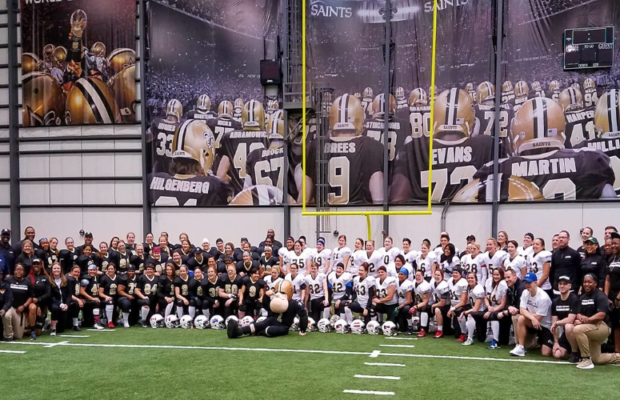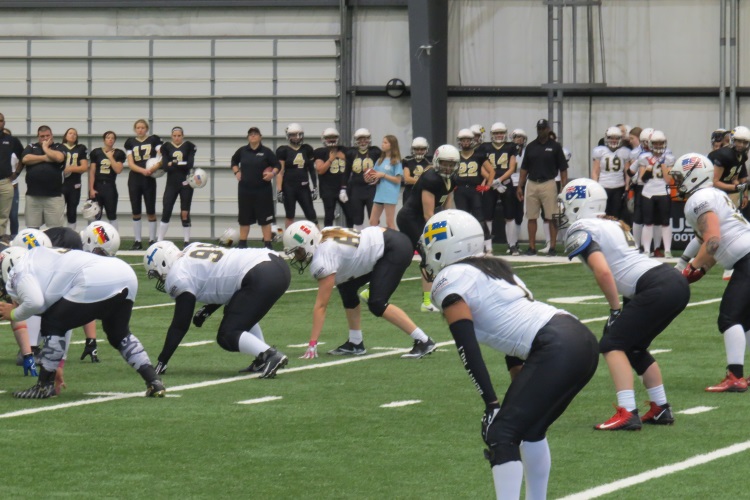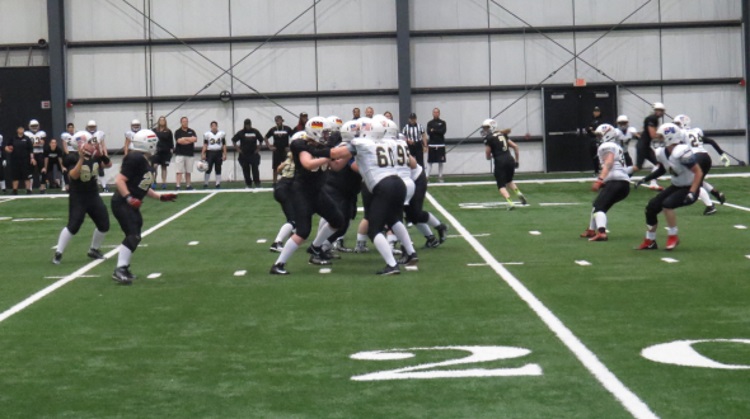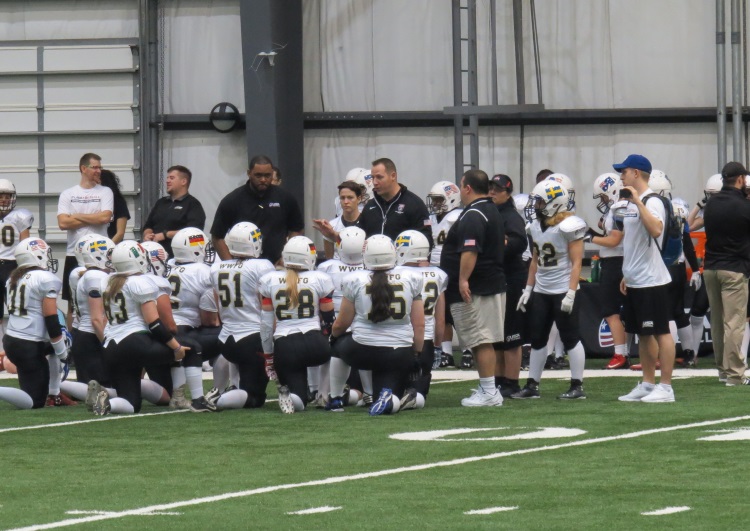5th Women’s World Games at New Orleans Saints facility another success!

The fifth edition of the Women’s World Games that USA Football put on from February 21-25 at the New Orleans Saint’s practice facility brought together a diverse group of women.
Melissa Bedwell started playing with the Lake Michigan Minx in 1998, and has been to all five WWGs. Nathalie Hacksell has yet to play a game for the Gothenburg Marvels, and was at her first WWG. Those who had previously attended the event, and rookies were evenly divided, but they were, in the phrase from Monday Night Football, “Ready for some Football!”.
However, despite the different experience levels, both Bedwell and Hacksell, along with the 80 other participants at the Games, shared a passion for playing football. At least two of players were sidelined by injuries, but still came to learn more about their positions and sport.
Games director Elizabeth Faust said that the games grew out of the 2013 IFAF Women’s World Championships in Finland. Faust remembered that Sam Rapaport, then with USA Football, wanted to have an event that would raise the level of women’s football globally. Rappaport, who is now an executive with the NFL, along with Faust, and other USAFB staff brainstormed ideas. The Women’s World Games were the result, and they were designed to be open to women with any skill or experience level, from any country.
USAFB held the first WWG in Arlington, Texas, and Faust, who was Rapaport’s intern at the time, remembered that 65-70 women from 6 countries attended. Last year, the number of attendees grew to 220 women from 20 countries, bolstered by the concurrent tryouts for Team USA to play in the IFAF WWC.
This year, Coach Jim Farrell, who has been the HC for all four WWGs, welcomed the players by reminding them how unique an experience this was. Since a large number of players have been to several Games, he already knew many of the players by name, and used them to illustrate the effort he wanted from the new attendees.
The oft repeated and posted phrase “Find your passion, and you will find your people” held true for the athletes gathered in Metairie, Louisiana. They had followed their passion for football, and it led to a large group of like minded individuals.
After four days of meetings and practices, the women were able to demonstrate that they had learned the techniques the coaches had taught them. HC Farrell was joined by a group of coaches with a good deal of experience, including playing and coaching in the NFL. Among them were Stephanie Balochko, who had interned with the Pittsburgh Steelers, and she was joined by a group of women such as Collette Smith, who served as an intern with the NY Jets, and were there to work on their coaching skills.
The 2018 game was somewhat different than last year’s Games. There were many more athletes last year, so the squads were split into beginners and veterans. This year’s smaller group was split into only two teams – the black jerseys versus the white. Robin Grove of the Capital City Rage (formerly the Sacramento Sirens) enjoyed the contrast. She enjoyed the smaller group and appreciated melding the rookies and veterans together, which she felt brought “a lot more togetherness between the countries and the players.”
The Game
The Black team scored first on a pass play to Steph Jackson, most recently of the DC Divas, but the unopposed conversion kick failed. Before the first quarter ended, they added a field goal to make the score 9-0. The White team finally got their offense on track led by Knengi Martin of the San Diego Rebellion, who spent most of her career as a hard hitting linebacker. Her play at quarterback often reverted to linebacker-like punishing runs that kept the White drive moving, and they scored with seconds left in the half to make the score 9-7.
The Black team went up 11-7 when an errant snap went over the White quarterback’s head and into the end zone. After that, the White took over on both sides of the ball. Another White quarterback from the USA passed to number 82 for a 52 yard touchdown, and after the PAT, the score stood at 14-11. Then a German player ran the ball into the end zone from the five, and the PAT was good to put White up at the final score of 21-11. Black challenged twice more, but came up short. In the third quarter, they were driving, and made it deep into White territory before White came up with an interception at their own 5 yard line. The Black offense finished the game deep in White territory, but that drive ended with 21 seconds left when number 72 from Germany recovered a Black fumble on the the White 4 yard line.
After the game, a few players were limping or had ice packs on their slight injuries, but all were smiling and happy with their experience. Players lingered on the field taking photos and congratulating each other. Alexandra Tornstrand, a tackle from the Stockholm Mean Machine, described the game as an extension of practice, during which defensive players helped their opponents. She reported that “One of the players from the D Line came to me and said you need to fix this and this, ’cause I can see it’,” and Tornstrand returned the favor. “It’s not just a game, we’re still practicing and getting better,” she concluded.
It will be interesting to see what effect the WWG has on the various teams that were represented this year. Sweden, in particular, had the most players of any country besides the United States with sixteen players. Whatever success occurs on the field, the WWG has succeeded in creating a global network of women who are certainly ready for some football.
Photos: Russ Crawford


